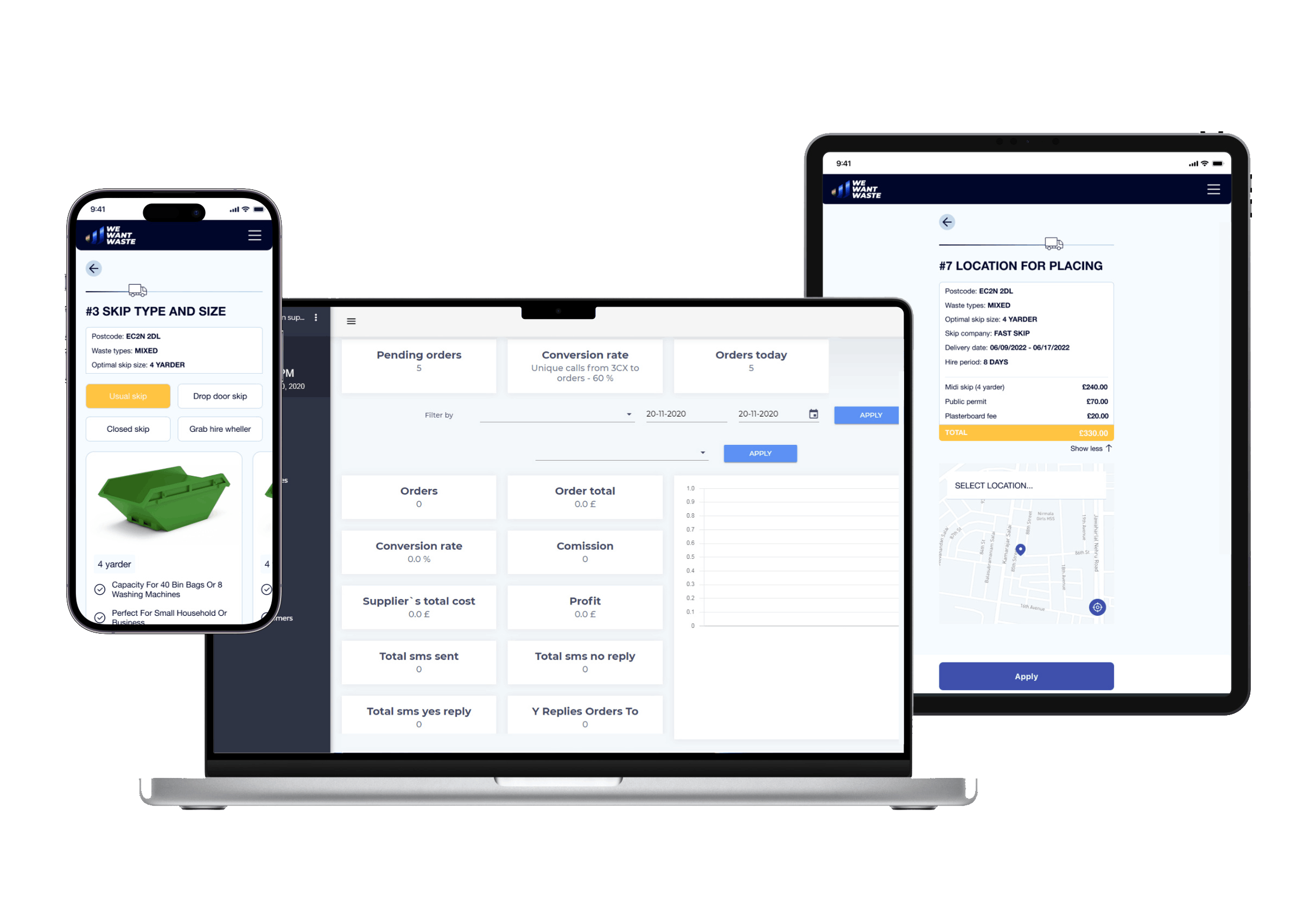Having a well-designed website is essential for businesses nowadays. However, it can be daunting to work out what this means for your company and how much you should be looking to spend.
According to the GoodFirms Web Development Costs Survey, a business website cost from $1000 to $50,000 last year. Given this wide range, it’s necessary to understand the factors that cause the difference in website development costs.
You risk overspending and failing to meet your business goals or user expectations without a clear understanding.
This guide explains website development's phases, approaches, and key roles. We’ll discuss the most important factors influencing costs and share strategies to reduce spending. Finally, you will find rough budget estimates for different types of sites across regions.
How Much Does Development for an Average Website Cost?
The cost of website development depends on several factors, including the website's complexity, the technical stack required, the expertise of the development team, and the project timeline. Without accounting for these specifics, a rough estimate ranges from $1,600 to $50,000.
Let’s break down these factors in more detail to help you better estimate your website development budget.
Factors That Influence Website Development Costs
So, how much does it cost to build a website? To give you a better idea, let’s first describe the different aspects of development.
Domain registration and hosting



The domain makes your website accessible to users online, while hosting provides the server space to store your files. Both require upfront and recurring payments, which vary based on the domain type, hosting plan features, and additional services.
Development cost factors:
- Domain extensions: Standard extensions like .com are cheaper than premium or niche-specific ones like .io or .tech.
- Visibility requirements: A previously used domain with backlinks can boost Search engine optimization (SEO) and rankings but may cost more.
- Hosting plan: Shared hosting reduces costs, but high-traffic sites may require more expensive dedicated hosting options.
- SSL certification: Adding a Secure Sockets Layer (SSL) certificate increases costs but is necessary for privacy compliance, higher search engine rankings, and user trust.
- Performance optimization: Services like content delivery networks, caching, or cloud storage improve page load time but add to hosting expenses.
UI/UX design


User interface (UI) and user experience (UX) design is about creating an appealing and intuitive interface. Complex designs with custom features, animations, and interactive elements increase costs. However, several factors influence the final price of development.
Development cost factors:
- Designers’ experience: Skilled designers or specialized firms charge higher rates due to their expertise in crafting high-impact designs.
- Unique page layouts and elements: A website with a single template for all pages will be much cheaper than a web app with numerous custom illustrations.
- User research and testing: Conducting surveys, interviews, and usability tests takes time but helps align the UI with user expectations.
Frontend development
Frontend development transforms UI/UX designs into fully functional web pages that users can interact with. It ensures navigation and features work seamlessly, optimizes page load times, and guarantees consistent usability across devices.
Development cost factors:
- Complexity of interactive features: Dynamic sliders, hover effects, collapsible menus, and real-time interactions require more coding by front-end developers.
- Frameworks and libraries: Modern frameworks (like React and Vue) streamline development but often require engineers with specialized expertise who charge higher rates.
- Mobile optimization: Developers need extra time to adjust the website for various screen sizes and device types.
- Performance improvement: Techniques like script minification and media compression enhance page responsiveness and load speeds.
Backend development
The backend handles server-side logic, integrations, database maintenance, and resource management. It’s responsible for behind-the-scenes processing, authentication, and data exchange.
Development cost factors:
- Technical complexity: Dynamic websites with custom features and complex integrations require more coding and testing than simple blogs or landing pages.
- Database management: Complex database handling (e.g., user information, uploaded media, inventories, payments) demands sophisticated backend logic.
- Technical stack: Programming frameworks and CI/CD tools vary in complexity and often come with licensing fees.
- Security Measures: Resources are needed to implement and test authentication mechanisms, encryption protocols, and data anonymization tools.


Admin panel development


The admin panel is a web-based interface that simplifies content management, feature configuration, and performance tracking. While it costs extra time and money to develop, it reduces dependency on engineers for routine updates.
Development cost factors:
- Feature range: Panels can include visual dashboards, analytical tools, and automated workflows, which require more resources to code.
- Third-Party integrations: Connecting the admin panel to email marketing platforms, CRMs, or other tools adds complexity.
- Customization level: Off-the-shelf admin panel solutions are more affordable but may not be flexible enough for specific needs
Marketing and content creation


Content and marketing drive traffic to your website, ensuring it reaches the right audience, converts visitors into customers, and sustains long-term growth. These costs should be allocated early in the planning stage.
Development cost factors:
- Content management: Writers and editors create pages, product descriptions, blog posts, and other content for the website.
- SEO efforts: Experts tweak on-page elements (e.g., keywords, meta descriptions) and off-page factors (e.g., backlinks, interlinks) to improve search engine visibility.
- Pay-Per-Click (PPC) campaigns: Researching competitive keywords, creating ad copies, testing landing pages, and configuring ad accounts.
- Social media management: Adding social sharing buttons, embedding feeds, and integrating analytics tools to gauge marketing effectiveness.
- Lead Magnet Development: Creating engaging tools like calculators, generators, chatbots, and other interactive features to attract and capture potential customers.
All these aspects require specialized expertise, which translates to additional costs.
Take the guesswork out of your website budget.
Get a tailored consultation to build a website without overspending.
Key Roles in Website Development
Website development is a coordinated effort involving professionals focused on specific aspects of the project. Understanding these key roles is essential when planning a website budget.


Project managers
The project manager (PM) coordinates the website-building process. Their role involves breaking development into manageable tasks for different teams, setting realistic timelines, and identifying potential risks.
Additionally, PMs act as a communication bridge between the client and the development team.
Managerial oversight ensures everyone understands project goals, technical requirements, and available resources. This helps the team focus on key features and avoid mistakes that could require costly reworking.
Designers
User interface (UI) and user experience (UX) designers analyze business documentation, target audience, design trends, and competitors’ sites. They use this information to sketch layouts, select typography and iconography, and define styles and color palettes.
Our UI/UX designers can analyze your audience, create user journey maps, and ensure seamless interaction with your product. Learn how we can improve your apps or build a prototype for a new website.
Developers
The development team’s experience, technical stack, and methodology directly influence website development costs. Certain frameworks, libraries, and tools will increase the budget. Meanwhile, poorly written code and security gaps will require extensive fixes, further increasing the price.
DevOps specialists
DevOps bridges developers and IT operations, ensuring the efficiency of the site’s infrastructure, deployment pipelines, and operational workflows.
They are responsible for Continuous Integration and Continuous Deployment (CI/CD), which largely automates code deployment and testing.
Experienced DevOps teams may be more costly, but they reduce immediate and long-term development costs. Automation of repetitive tasks allows faster feature rollouts.
DevOps teams also ensure efficient resource use with auto-scaling and load-balancing and employ proactive monitoring and recovery mechanisms to minimize costly downtime.
QA professionals
The Quality Assurance (QA) team ensures the website meets the strictly defined acceptance criteria. They extensively test core functions, security mechanisms, performance, and usability.
In addition to testing, QA professionals validate the integrity of the website development process itself. They oversee testing plans, ensure adherence to agreed workflows, build automation scripts, and set up CI/CD pipelines. These practices help reduce costs by avoiding expensive revisions.
Content managers and SEO
Writers, content creators, and marketers are responsible for the information on the website. They usually plan regular updates, such as blog posts and newsletters, to keep the site engaging for viewers.
SEO teams optimize content to convert readers into users and active users into paying customers. They also enhance pages to appeal to search algorithms, increasing your website’s visibility on search engines.
A successful website typically involves all these roles. Neglecting any of them can lead to gaps in development and functionality.
Development Approaches that Affect Website Costs
In most cases, you’ll either develop a website with your team, hire independent experts, or outsource the job to another company. Which method you choose affects the costs involved. Let’s consider each approach.
In-house developers
Internal employees work closely with your company, aligning with your values, goals, and culture. You directly oversee their activities, enjoy real-time communication, and have complete control over the development process.
However, building an in-house team can be expensive. You must allocate resources to finding, vetting, and training the team. Full-time employees require competitive salaries, benefits, and potential bonuses. In the United States, an experienced web developer can earn between $50,000 and $150,000 annually.
Retaining skilled developers is equally resource-intensive. Developers must stay updated with industry trends, tools, and best practices. This may involve enrolling them in training courses, attending conferences, or obtaining certifications.
Complete control:
You can oversee every aspect of the project, adjust priorities, and micro-manage.
High financial commitment:
An in-house team is expensive and requires a lot of immediate costs and ongoing expenses (from salaries and bonuses to rental expenses).
Instant communication:
In-house teams collaborate seamlessly, provide instant updates, and address your requests immediately.
Long recruitment process:
Finding, interviewing, and onboarding new team members can be lengthy and delay the website development.
Team cohesion:
Employees develop a deep understanding of your brand, target audience, and vision.
Skillset stagnation:
Working exclusively on your projects can limit exposure to new technologies, narrowing your employee's scope.
Cost-efficiency for long-term projects:
In-house teams are more economical if your website requires consistent updates.

Freelancers
Independent professionals can help you develop, design, or add content to your website affordably. You can tap into the global talent pool and negotiate a payment model. Depending on their location and skill set, rates can range from $20 per hour for junior developers to $250 per hour for senior developers.
Freelancing is often well-suited for smaller websites, limited features, or one-off development tasks. However, managing multiple independent workers is challenging. They often juggle several projects and may not fully adapt to your policies, leading to coordination problems or inconsistent outcomes.
Lower costs:
Freelancers typically charge less than agencies or full-time employees for the same tasks, and you don’t have to spend money on retaining or training.
Inconsistent availability:
As independent contractors, freelancers may be handling several projects, and yours may not always be at the top of their list. A delay from elsewhere on your project can lead to a freelancer being unable to accommodate urgent requests or missing deadlines.
Specialized focus:
Freelancers can be hired on a project-by-project basis, depending on skill requirements.
Limited scalability:
They often lack the capacity or resources to manage large-scale or ongoing projects. An independent PM is a risky choice for an e-commerce website.
Global talent pool:
Businesses can find top-tier talent in regions with lower market rates, such as Eastern Europe, Southeast Asia, or Latin America.
Quality risks:
The absence of a standardized review process and communication barriers may lead to inconsistent or subpar work.

Outsourcing companies
Professional outsourcing companies bring diverse teams of specialists, including UX/UI designers, frontend and backend engineers, QA professionals, and content managers.
This approach is ideal for businesses without internal technical expertise or those looking for a hands-off approach to development. Costs can range from $5,000 for a basic website to $100,000 or more for a highly customized, enterprise-level web application.
The key advantage is you can agree in advance on how much it costs to build a website. Of course, you still need to research agencies and account for numerous factors when finding a partner.
Comprehensive expertise:
Highly rated outsourcing companies provide their teams of experienced designers, engineers, SEO experts, and project managers.
Higher upfront costs:
Agencies are typically more expensive than hiring freelancers but more affordable than managing an internal team.
Operational scalability:
Agencies can adapt to evolving project needs and allocate resources for additional tasks.
Hard to vet:
You still must account for expertise, technical stack, time zone differences, language barriers, and other factors when researching candidates.
Structured processes:
Reputable companies use established workflows and development methodologies to ensure consistent quality.
Less direct control:
Most companies manage projects independently, which means you have less direct influence and may need to go through formal change requests to adjust requirements.
Post-launch support:
Outsourcing companies can maintain your website after deployment, delivering performance optimization, bug fixes, and a technical helpdesk.

Giraffe can develop complex web platforms and single-page apps from scratch or update your existing website. Meanwhile, the website development costs are agreed in advance.
The Website Development Process
Websites go through several phases. You might repeat some of them for more complicated products that require multiple iterations.
Website Development Process

Research and Discovery

Design Stage

Coding and Testing

Deployment, Monitoring, and Support

1. Research and discovery
Define the website’s purpose, type, and target audience. This will help shape the objectives, goals, and technical requirements. Vague technical requirements and unclear direction can lead to multiple design revisions, each adding to the total cost.
This stage also helps evaluate whether the desired features and integrations are feasible and achievable within the budget. However, clear estimates require thorough research and experienced developers who have worked on similar websites.
Need a skilled web team?
We handle everything from research to post-launch maintenance.
2. Design stage
Developing effective UI/UX involves multiple stages, including user research, wireframing, prototyping, and usability testing. The process often includes several drafts and revisions to incorporate feedback, which increases the hours and costs.
Prioritizing user preferences ensures the design resonates with the target audience. Designers and developers should collaborate closely before the coding even begins to avoid costly missteps.
3. Coding and testing
Developers translate the UI/UX designs into functioning code and handle server-side logic. The deployments are continuously tested and validated to ensure correct scaling, performance, functionality, and security.
The website must pass the predefined standards before it’s ready to be launched for public use. In addition to testing the usability and security, you should measure user acceptance and ensure industry-specific regulatory compliance.
4. Deployment, monitoring, and support
Domain configuration, SSL certification, and database management must be handled before deployment. Post-launch, businesses often need to update content or add new features based on user feedback.
Regular audits and maintenance prevent performance issues and security vulnerabilities. Updates for third-party integrations and compatibility checks with emerging technologies should be conducted regularly. Meanwhile, content and SEO updates keep the site visible to search engines.
Each phase contributes to the project's success. Usually, the better you plan, the fewer iterations and lower costs you will incur.
Costs of Different Types of Websites
The difference in website costs depends entirely on your demands and scope. However, we can provide rough estimates based on types.
Landing pages
Landing pages are single-page sites designed to drive a specific user action, such as signing up for a service, downloading an eBook, or purchasing a product. They are among the least expensive websites to build, especially if based on pre-designed templates and no-code solutions.
Costs
Platforms like Wix, Squarespace, and Webflow can reduce the page cost to $300. Meanwhile, custom-designed landing pages with tailored graphics, professional copywriting, and A/B testing capabilities may cost several thousand dollars.
Examples:
- Sunbasket combines vibrant visuals with persuasive copy and a clear CTA (“Get Started”) to maximize conversions.
- Twilio focuses on delivering a clear message about its API capabilities.
Business card websites
A business card website provides a snapshot of a company’s services, contact details, and brand identity. These websites are typically small, consisting of three to five pages.
Costs
A basic business card website built on platforms like WordPress or Joomla can cost $500–$2,500. Custom elements and dynamic forms may push the price to $3,000–$5,000.
Examples:
- Black Frame is a photography-focused business card site with high-quality images and simple navigation.
- Hampshire Light uses elegant typography and subtle animations to convey a premium aesthetic.
Corporate websites
Corporate websites explain your business, conveying its services, products, achievements, and future objectives. They are much more detailed than business card sites and include advanced features like client portals, interactive media, and third-party integrations.
Costs
Custom corporate websites may cost $5,000–$15,000 depending on the features, graphic design, content, and SEO requirements.
Examples:
- HSBC features custom animations, financial tools, and secure portals.
- JP Morgan presents key information, provides a secure client portal, and offers numerous additional resources.
Blogging sites
Blogs emphasize content creation and audience engagement, often focusing on specific niches like technology, lifestyle, or education. These can be simple blogs about niche topics or complex platforms that aggregate user-generated content.
Costs
A basic WordPress blog with low-cost templates costs $100–$1,000. More advanced platforms with unique themes, subscription options, and social media integrations can raise costs to $10,000.
Examples:
- Medium and Substack have advanced features that help users read, create, publish, and monetize articles.
News media
News sites and publications prioritize frequent updates, editorial tools, and multimedia integration. They usually require robust content management systems, tagging and category functions, and integrations with ad platforms and payment gateways.
Costs
Custom news sites with contributor management functionality can cost $5,000–$50,000. However, many top-tier platforms exceed $100,000 in development costs.
Examples:
- The Guardian and The Telegraph focus on multimedia and social sharing features with advanced subscription models.
Community forums
Forums require content moderation, authentication tools, a responsive design, and search functionalities. The target audience for such platforms particularly requires a friendly UI and scalable architecture capable of handling increased user numbers (especially if you allow posting media).
Costs
Community website development costs can range from $500 to $5,000, but advanced moderation, real-time support, or other integrations can raise the cost to $10,000 or more.
Examples:
- Quora and Stack Overflow are great examples of forums with reputation-scoring features and advanced search.
Streaming web apps
Video and audio streaming sites involve complex technical requirements, including robust hosting infrastructure, video encoding, and scalable content delivery networks. They demand substantial investment in frontend and backend development, payment gateway integrations, recommendation algorithms, and continuous UX improvements.
Costs
Streaming platforms that support high-quality content and encoding capabilities cost $20,000–$50,000 (plus significant sums for maintenance and optimization).
Examples:
- YouTube combines user-generated videos with live-streaming and sophisticated algorithms for recommendations.
- Netflix uses robust algorithms, extensive account management features, and scalable architecture that handles thousands of 4K movies and shows.
E-commerce platforms
Digital store management platforms require product catalogs, inventory management, and payment processing features. The costs vary significantly based on the product catalog size, the complexity of search and filtering options, and integrations.
Costs
Costs Platforms like Shopify can cost $500–$5,000 annually for licensing and templates, with custom enterprise stores costing up to $100,000.
Examples:
The Average Cost to Build a Website Across Region
Type of Website
Development Time
US Rates
India Rates
Western Europe Rates
Eastern Europe Rates
Landing page
20–40 hours
$1,500–$4,000
$200– $800
$700– $2,400
$400– $1,400
Business card website
30–50 hours
$2,500–$7,000
$300– $1,000
$1,050–$3,000
$600– $1,750
Corporate website
80–120 hours
$8,000–$15,000
$800–$2,400
$2,800–$7,200
$1,600–$4,200
Blogging site
40–60 hours
$3,500–$7,000
$400– $1,200
$1,400–$3,600
$800– $2,100
News media
100–200 hours
$10,000–$20,000
$1,000–$4,000
$3,500–$12,000
$2,000–$7,000
Community forum
80–130 hours
$6,000–$12,000
$800–$2,600
$2,800–$7,800
$1,600–$4,500
Streaming platform
150–250 hours
$15,000–$50,000
$1,500–$5,000
$5,250–$15,000
$3,000–$8,750
E-commerce site
100–200 hours
$10,000–$50,000
$1,000–$8,000
$3,500–$24,000
$2,000–$10,000

The location of your developers or outsourcing partner makes a world of difference. Compared to the US and UK companies, Giraffe can help you save up to 75% of your costs.
How Giraffe Software Can Help You Create a Website
Website development consists of numerous decisions, each with a price tag. To plan your budget correctly, you must account for every phase, from research and UI/UX design to selecting backend infrastructure.
At Giraffe Software, we follow a streamlined, efficient process to deliver high-quality websites with a proven high success rate. One example of our expertise is our collaboration with Looxis, a German company known for crafting personalized 3D crystal gifts.

Looxis
Initially, Looxis needed a robust platform to handle complex product customization and deliver an engaging user experience. Our solution provided both interactivity and functionality, enabling effortless order personalization. The web solution for Looxis entailed:
- Team of experts: A dedicated team of two developers, one QA specialist, and a project manager ensured the project’s smooth execution.
- Interactive product customizer: Created a 3D preview tool, allowing users to upload images and view real-time customization of their crystal gifts.
- Order management system: Built a seamless backend for order tracking, inventory management, and customer support, ensuring operational efficiency.
- UI/UX excellence: Designed a modern, intuitive interface for an enjoyable and user-friendly experience.
- Scalability & performance: Developed the platform to handle high traffic and accommodate future growth without compromising speed or functionality.
Tangible results:
- Boosted user engagement by 35%.
- Streamlined operations for faster and more efficient order processing.

Looxis

2 weeks
To assemble the team
2 months
To build an online store
29%
Of budget saved
5 Years
Cooperation Time
Explore our case studies to see how we deliver results for businesses like yours.
Contact us today to discuss your project and discover how our cost-effective web development approach can bring your vision to life!
Tags:
AUTHOR

Prystupa Eugene
Co-Founder
Eugene is a Co-Founder and CTO at Giraffe Software. He is seasoned technology executive with over 10 years of experience in the industry. Eugene leads the development and execution of the company's technology strategy, driving innovation and ensuring alignment with business goals.

Aligned in both project goals and work style, Giraffe Software has proven to be a productive, cost-effective partner. Their clear communication and adaptability have earned them an expanded scope.

Johannes Renaud
Director, LOOXIS GmbH
 Germany
Germany
Their reliability, tech expertise and quality of service set them apart. Giraffe Software is responsive and accommodating, establishes a smooth workflow through open communication.

James Lenoble
CEO, GrowMindGrow
 USA
USA
I am happy I can finally start gaining traffic and fulfill my goals. The vendor's collaboration method has been a strength, as they listen carefully to ensure complete understanding of objectives and challenges.

Ori Levi
Owner, Sosimple
 Israel
Israel
We liked their work so much we've brought them onboard other software development projects. Giraffe Software's project management, rates, and quality of code were all excellent.

Johan van der Walt
President and CEO, Evosolve
 Hungary
Hungary

 Ukraine, Dnipro
Ukraine, Dnipro
Mechnikova str. 19, office 705
 Estonia, Tallinn
Estonia, Tallinn
Harju maakond, Kesklinna linnaosa, Kaupmehe tn 7-120







